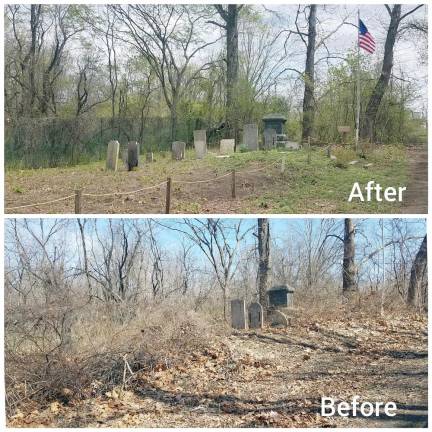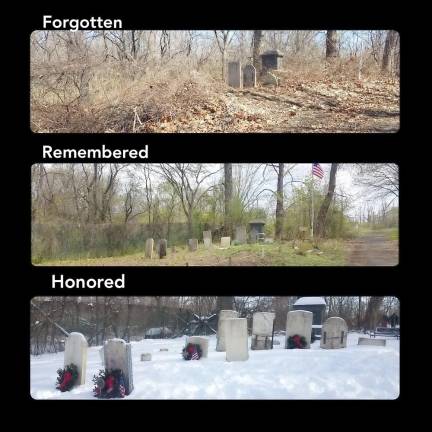Good deed restores honor to the dead
Chester. Among those buried is one of George Washington’s generals during the American Revolution.
Diana KyDon describes herself as just a volunteer who saw an overgrown cemetery and thought: “No one deserves to be forgotten.” That was her inspiration to clean up a burial ground deep in the woods.
She had seen it years before — and thought there were only three or four headstones. She’d been thinking about cleaning it up for a long time. Little did she know she’d be uncovering history.
She started in March, when the shutdown due to the coronavirus began. She told her husband George: “It’s not cold out; I’m going to go out and start working on it.”
Her husband said: “Knock yourself out,” and told her to call if she needed help.
’I kept finding more’
“When I started I thought there were three or four stones and as I kept clearing,” KyDon said, “I kept finding more and more.”
Over many months, KyDon, and sometimes her husband, repeatedly went out to the site on ATVs with chain saws, axes and pole saws to cut away all the brush, which was very tall in places.
“My husband helped with the big chain saw and pole saw,” she said.
The flag pole was missing its halyard, and George helped take the heavy pole down. They put on a new halyard and flag and raised it back up.
Friends get involved
They enlisted a friend to cut wooden slats for the benches they installed. They began with just wrought iron ends and put everything together at their home and then transported them. They installed steps and fencing rope posts.
The couple’s close friends have also gotten involved, occasionally laying fresh flowers on the graves or raking leaves.
At the KyDons’ request, the name and location of the cemetery out because of fears of vandalism. The couple had purchased and installed metal grave markers which were stolen by vandals. The markers are now in concrete.
Figuring out who was how
The pair righted fallen stones and started cleaning them and after a while, they could make out the names. Many shared the same name. KyDon looked them up online and matched dates to figure out who was who and built up a genealogical list.
One of the deceased was one of Washington generals during the American Revolution. He and his family were significant in the early years of Orange County, serving during war and in government in peace, surveying the land and donating land for a school.
One of his descendants, Caroline, was a young woman when she died and was interred in the family plot. “Caroline’s grave was completely under the dirt; covered with poison ivy, vines and trees,” KyDon said. “When I got to bottom level of soil my rake scraped against something. Caroline’s headstone was there-broken in two pieces. We fixed it with big pieces of angle iron and finally got Caroline’s stone upright.”
A descendant of the family, Marcia Faber of Goshen, owns a family heirloom, a sampler made by Caroline before she died aged just 26.
In total KyDon identified 16 stones; the different generations appeared to have been buried in descending rows. She built a pedestal at the entrance and is applying for a NYS historic marker.
The stones give a hint of the depredations of disease at the time. There are graves of infants and very young children as well as graves of family members who died within a short time of each other.
She spoke to the landowner, who told her it would be written into any sale of the land, that the cemetery would be protected and maintained.
“I did it for a good deed,” KyDon said, “and nothing more.”

